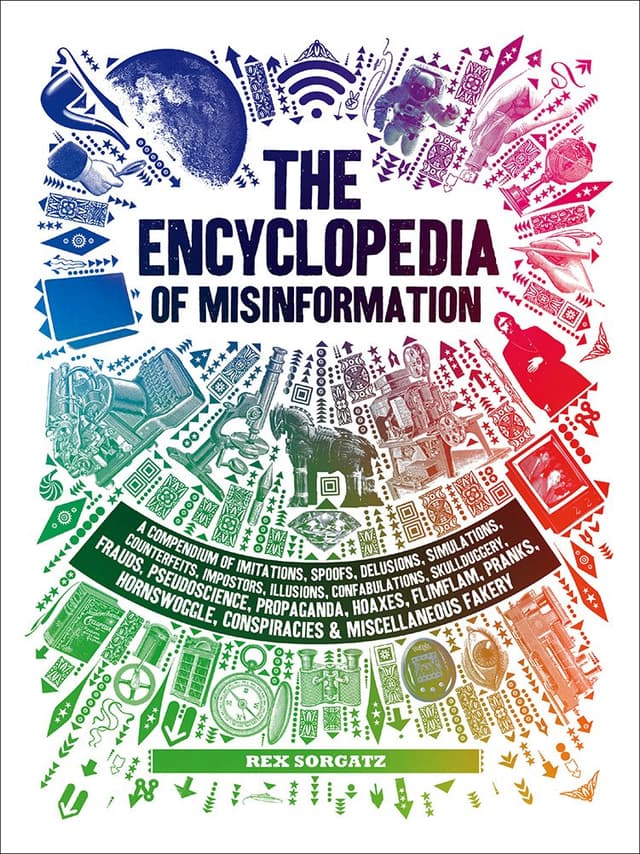Rex Sorgatz | November 1, 2019
Why is this interesting? - The Eternal Celebrity Edition
On movies, deepfakes, and the de-aging of stars
Recommended Products

A comprehensive encyclopedia about counterfeits, confabulations, and various miscellaneous deceptions.
Rex Sorgatz (RS) wears a lot of hats. He’s one part media theorist, one part cultural observer, and one part creative technologist. He wrote an actual Encyclopedia of Misinformation and has been a longtime fixture in the most interesting NYC circles and we forgive him for his mid-2000’s Gawker-era fameball phase. Hopefully, he starts writing his Recs email again soon because it is great.
Rex here. When Martin Scorsese's The Irishman hits theaters this weekend, it will represent the latest salvo in Hollywood's great march towards prolonging youth. Much of the cast — including Robert De Niro (76), Al Pacino (79), and Joe Pesci (76) — play characters 30+ years younger. Their faces have been digitally de-aged, like deepfake Goodfellas.
Hollywood has always pushed the limits of how much artifice audiences will swallow, but digital youthification has accelerated like quicksilver over the past few years. In 2015, when the actor Paul Walker died in the midst of shooting a Fast and Furious movie, audiences seemed to accept his digital resurrection as a necessary condition of completing the film. But the following year, a Star Wars spin-off, Rogue One, would go a step further, not only de-aging beloved actress Carrie Fisher by 40 years, but resurrecting the actor Peter Cushing, who died 22 years prior. Some audience members flinched at the on-screen zombies, but the floodgates had sprung a leak.
The Fountain of Youth would soon gush like a geyser across the Uncanny Valley.
Why is this interesting?
If you view Hollywood as a series of calculated psychology experiments (who doesn't?), The Irishman is a provocative next step. This lab test of a movie will be the first time major actors receive dramatic (and highly realistic) digital facelifts through the majority of a film. After watching three hours and 28 minutes of De Niro and Pacino rejuvenated to their prime, viewers completely forget the gimmick. De-aging, the film implicitly argues, is now commonplace.
Beyond simple normalization lurks another huge factor: It's frickin Martin Scorsese! It was one thing to de-age action heroes, but the pedigree of The Irishman acts as an imprimatur, authorizing the rest of Hollywood to freeze-frame the visages of our greatest icons for future use.
Remember this moment: Virtual cryogenics has been officially sanctioned.

What's next? Now that the public accepts de-aging (thanks Scorsese!), and the technology has been perfected (thanks deepfakes!), it seems only a matter of time before a deceased actor wins an Oscar after digital resurrection. The only remaining question is, Who will it be? Audrey Hepburn? Orson Welles? Tom Hanks 2.0? (My money is on Tom Cruise. The facemask gag on Mission: Impossible already smacks of Hollywood sublimating its guilt over enabling bionic Frankensteins.)
Movie studios are behind the most significant force propelling this trend: The grinding assault of IP-based entertainment. It's no secret that rebooted franchises, sequels, and cinematic universes dominate the cineplex today. (All 10 of last year's top 10 movies were IP-based.) By pairing de-aging tech with intellectual property, movie studios will inevitably become reincarnation machines, perpetually recycling characters from the past. As deepfake technology gets cheaper, churning out Benjamin Buttons will become routine.
Just imagine: At some point in the future, an entertainment exec will likely propose rebooting Game of Thrones with a teenage Daenerys, still played by Emilia Clarke, no matter her age. Would you watch that? I would! If J.J. Abrams someday gets a terrific script for Forrest Gump 2: The Trump Years, will it get made, regardless of Tom Hanks' liveliness? Of course! (His likeness was already mo-capped in 2004 for The Polar Express.)
Given where things are headed, making movies with dead actors sounds totally plausible. Maybe even inevitable? At some point, an intrepid producer will undoubtedly ask, Do we even need living actors at all?
There are still a few legal questions — related to ownership of character versus likeness of actor — to be sorted out. (I smell another WITI on the horizon.) But if the petri dish known as Hollywood has proven anything, it's that consumer demand finds a way of resolving intractable problems. And consumers are clearly demanding we make old stars young again.
Welcome to the dawning of a new age: The Eternal Celebrity. (RS)
Image of the Day:
The movie poster for Gemini Man, released in early October, is practically an advertisement for the future of Hollywood: Celebrities made eternally younger. (RS)

Quick Links:
Above, I mentioned the future legal issues related to deepfakes and Hollywood. Here's a good overview. (RS)
How to make Danish open-faced sandwiches via BP (CJN)
I feel sad that I’ve only just discovered this treasure trove of David Lynch-directed television commercials. Make sure to watch the Barilla commercial with Gerard Depardieu and the completely insane Adidas ad. (NRB)
Thanks for reading,
Noah (NRB) & Colin (CJN) & Rex (RS)
Why is this interesting? is a daily email from Noah Brier & Colin Nagy (and friends!) about interesting things. If you’ve enjoyed this edition, please consider forwarding it to a friend. If you’re reading it for the first time, consider subscribing (it’s free!).